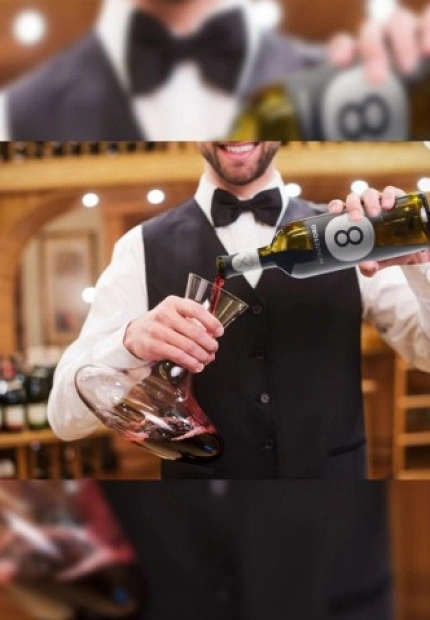Decanting wine
Decanting a wine is like performing a ritual, a dance that awakens the senses and elevates the tasting experience to a higher level. This process, which goes beyond simply opening a bottle, involves care and patience, with the aim of enhancing the qualities of the wine and allowing it to "sing" at its best.
Let's imagine wine as a musical score and decanting as tuning an instrument before a performance. When we pour wine into a carafe or decanter, we release it from the bottle and allow it to "sing" as it comes into contact with oxygen. This contact is key, since oxygen awakens the aromas and flavors that have been dormant in the bottle, allowing the composition to fully unfold.
One of the most notable benefits of decanting is the elimination of possible sediments. This is especially relevant for older wines or those that have spent significant time in barrel. By carefully pouring the wine, we can separate these sediments, ensuring that our glass is filled with only the purest, brightest essence of the wine.
Furthermore, decanting plays a crucial role in oxygenating the wine. Upon contact with air, the molecules of the wine gradually open up, releasing aromas that may have been "locked" in the bottle. This process not only improves aromatic expressiveness, but also softens tannins, especially in young, robust red wines.
In the case of reds, oxygenation can transform a closed and tense wine into a symphony of softer and more balanced flavors. It is as if, by decanting, we are giving the wine the time and space necessary to find its internal harmony. This sensory enrichment can make the wine tasting experience deeper and more satisfying.
The choice of decanter also influences the process. Specific shapes and designs are designed to enhance different aspects of the wine. Wide decanters allow greater exposure to oxygen, benefiting younger, more tannic wines, while narrower decanters can be ideal for older wines, preserving their delicacy.
It is important to note that not all wines need or benefit from decanting. More delicate or ephemeral wines, such as some white or sparkling wines, can lose their freshness if they undergo a prolonged decanting process. It is essential to know the profile of each wine and adapt the decanting ritual accordingly.
In addition to improving organoleptic characteristics, decanting also adds a theatrical component to the wine experience. Carefully pouring the crimson liquid into the decanter, watching it spiral inside, and then finally pouring it into the glass creates a moment of anticipation and celebration.
Patience and consideration are key in this process. Decanting should not be rushed; It is an act of respect towards the wine and towards those who will share the experience. It allows the wine to breathe and gradually open, revealing layer after layer of its personality.
In short, singing a wine through decanting is a way to unlock its full potential. By releasing captive aromas, softening tannins and removing sediments, we allow the wine to reach its maximum expression. This ritual goes beyond the functional; is a celebration of the art and science of oenology, bringing wine tasting to a rich and satisfying multi-sensory experience

